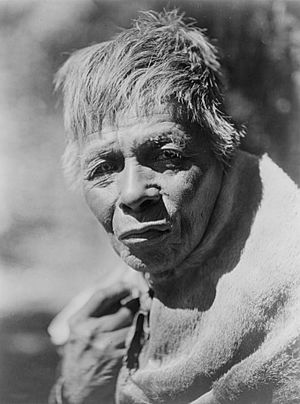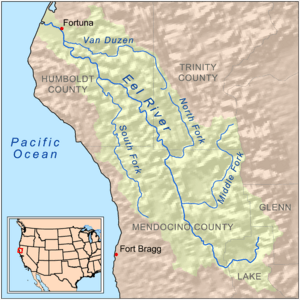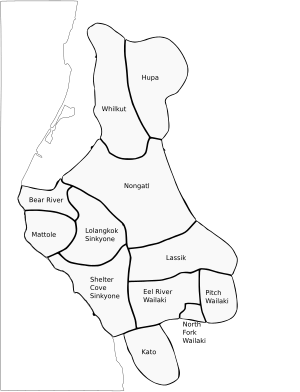Eel River Athapaskan peoples facts for kids

A Wailaki man by Edward S. Curtis, c. 1924
|
|
| Regions with significant populations | |
|---|---|
| California | |
| Languages | |
| Eel River language, American English | |
| Religion | |
| Animism (historically), Christianity |
The Eel River Athabaskans are a group of Native American peoples. They include the Wailaki, Lassik, Nongatl, and Sinkyone (Sinkine) groups. These groups traditionally lived in what is now Mendocino, Trinity, and Humboldt counties in northwestern California. Their homes were on or near the Eel River and Van Duzen River.
These groups speak different forms of the Wailaki language. This language belongs to the Pacific Coast Athabaskan group. This larger Athapaskan language family is also found in Alaska, western Canada, and the southwestern U.S.. Other related Athapaskan groups lived nearby. These included the Hupa-Whilkut-Chilula to the north, the Mattole on the coast to the west, and the Kato to the south.
During the 1860s, a conflict called the Bald Hills War greatly affected the Whilkut, Nongatl, and Lassik peoples. Many people from these groups were lost during this time. Today, some Wailaki people are registered members of the Round Valley Indian Tribes of the Round Valley Reservation.
Who Are the Eel River Athabaskans?
The Eel River Athabaskans are known for their strong connection to the land and rivers of northwestern California. Their way of life was deeply tied to the natural resources around them. They had rich traditions and cultures that were passed down through generations.
Important Eel River Athabaskan Groups
Several distinct groups make up the Eel River Athabaskan peoples. Each had its own territory and unique customs, but they shared a common language family and cultural ties.
The Nongatl People
The Nongatl people traditionally lived around the Van Duzen River. This area stretched from where the river meets the Eel River all the way to its source near Dinsmore, California. They also lived along Yager Creek and Larabee Creek. The word Nongatl comes from the Hupa word meaning "Athapaskan to the south." Historical records suggest they had at least 35 villages in their territory.
The Lassik People
The Lassik people had about 20 villages. Their territory included a part of the main Eel River south to Kekawaka Creek. It also covered its eastern branches like the Van Duzen River, Larabee, and Dobbyn creeks. They also lived near the sources of the North Fork Eel River and Mad River. Their language was similar to Hupa in its grammar and Wailaki in its sounds. Sadly, many Lassik people faced great hardship when white settlers arrived in their lands. A few families still live near their traditional homes today.
The Wailaki People
The Wailaki people call themselves Kinist'ee, which means "the people." The name Wailaki comes from a Wintun term meaning "north language." They lived in northwestern California, along the Eel River south of Kekawaka Creek and the North Fork Eel River.
The Wailaki were divided into three main groups:
- Tsennahkenne or Eel River Wailaki: These lived along the main Eel River.
- Bahneko or North Fork [Eel River] Wailaki: They lived along the North Fork Eel River.
- Che-teg-gah-ahng or Pitch Wailaki: These were located further up the North Fork of the Eel River.
These groups were made up of many smaller bands and had almost 100 villages in total. Each band had specific areas where they lived and gathered resources.
Tsennahkenne (Eel River Wailaki) Bands
The Tsennahkenne lived on both sides of the Eel River. Their territory stretched from Boulder Creek to Cottonwood Creek, and then south on the west side to the Yuki border. Some of their bands included:
- Bis-kaiyaah: Also called Ch'inisnoo'-kaiyaah, this band lived on the eastern side of the Eel River.
- Daadii'schow-kaiyaah: This band lived on the western side of the Eel River.
- Kaikiitce-kaiyaah: Also known as Shaahnaa'ndoon'-kaiyaah, this band lived on the western side of the Eel River.
- Nin'keniitc-kaiyaah: Also called Nee'taash-kaiyaah, this band lived on the western side of the Eel River, near the North Fork.
- Seetaah-kaiyaah: This band lived on the western side of the Eel River.
- Seeyaadin-kaiyaah: Also known as Slaa-kaiyaah, this band lived on the eastern side of the Eel River.
- Tciiskot-kaiyaah: Also called Toos'aan-kaiyaah, this band lived on the eastern side of the Eel River.
Bahneko (North Fork Eel River Wailaki) Bands
The Bahneko lived on both sides of the North Fork Eel River. Their area extended from its mouth up to about a mile from Asbill Creek. They also lived on the east side of the Eel River between Cottonwood Creek and the Yuki border. Some of their bands included:
- Kaiyeeh-kiiyaahaan: This band lived on both the north and south sides of the North Fork Eel River.
- Nee'lhtciichow-kaiyaah: This band lived on the eastern side of the Eel River.
- Seechow-kiiyaahaan: This band lived on both sides of the North Fork Eel River.
- Seelhgaichow-kaiyaah: This band lived on the eastern side of the Eel River.
- Seelhtciichow-kaiyaah: This band lived on the eastern side of the Eel River.
- Seetaandoon'-kaiyaah: This band lived on the north side of the North Fork Eel River.
Che-teg-gah-ahng (Pitch Wailaki) Bands
The Pitch Wailaki lived along the North Fork Eel River, from Asbill Creek all the way up to the Lassik border. This area included Hull's Creek and Casoose Creek. Some of their bands included:
- Ch'i'aankot-kiiyaahaan: This band lived on Hull's Creek and Casoose Creek.
- Chowkot-kiiyaahaan: This band lived on the North Fork Eel River.
- T'ohchaah-kiiyaahaan: This band lived on both sides of the North Fork Eel River.
- T'ohdinin'-kiiyaahaan: This band lived on both sides of the North Fork Eel River.
The Sinkyone (Sinkine) People
The Sinkyone people had about 70 villages. Their lands were along the Eel River and South Fork Eel River. They also lived along a part of the coastline, starting from Spanish Flat and going south.
How They Used Plants
The Wailaki people were very skilled at using plants from their environment. For example, they would weave the roots and leaves of a plant called Carex into baskets. They also used the leaves of this plant to weave mats. This shows how resourceful they were and how well they understood the plants around them.
Population Changes Over Time
It's hard to know exactly how many Native Americans lived in California before Europeans arrived. Experts have made different guesses.
- Early Estimates (around 1770):
* Alfred L. Kroeber thought there were about 2,000 Nongatl, Sinkyone, and Lassik people combined. He estimated about 1,000 Wailaki. * Sherburne F. Cook suggested a total of 4,700 for the Nongatl, Sinkyone, Lassik, Wailaki, Mattole, and Kato groups together. * Martin A. Baumhoff gave higher numbers: 2,325 Nongatl, 4,221 Sinkyone, 1,411 Lassik, and 2,760 Wailaki. This would be a total of 10,717 for the four Eel River Athabaskan groups.
- Later Estimates (around 1910):
* Kroeber estimated that the combined population of the Nongatl, Sinkyone, and Lassik had dropped to about 100 people. * He estimated the Wailaki population at around 200 people.
Today, descendants of the Wailaki people are part of several recognized tribes. These include the Scotts Valley Band of Pomo Indians of California, the Grindstone Indian Rancheria of Wintun-Wailaki Indians, and the Round Valley Indian Tribes of the Round Valley Reservation.
|




